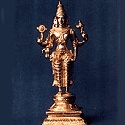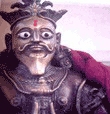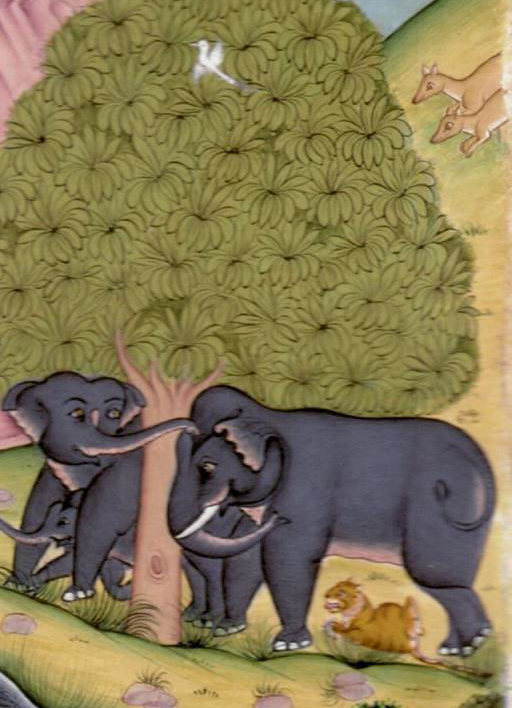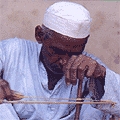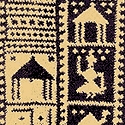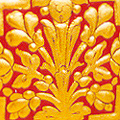Bronze Icon Casting of Andhra Pradesh,
Icon making of various deity forms is an ancient traditional craft in Andhra Pradesh. The deity forms that are made adhere scrupulously to the exacting standards of the ancient Shilpa Shastras in terms of physical anatomy and other characteristics, combining with it basic principles of aesthetics. A hereditary craft, its principles are passed down from generation to generation. Miniature bronze castings are created by craftespersons from Dornakambala and Perumallapalli in the Chitoor district and Dowlaiswaram in East Godavari. The artisans excel in the creation of exquisite deities and their modelling draws inspiration from nature.
Icon making of various deity forms is an ancient traditional craft in Andhra Pradesh. The deity forms that are made adhere scrupulously to the exacting standards of the ancient Shilpa Shastras in terms of physical anatomy and other characteristics, combining with it basic principles of aesthetics. A hereditary craft, its principles are passed down from generation to generation. Miniature bronze castings are created by craftespersons from Dornakambala and Perumallapalli in the Chitoor district and Dowlaiswaram in East Godavari. The artisans excel in the creation of exquisite deities and their modelling draws inspiration from nature.
Bronze Icons and Metal Craft of Rajasthan,
In Rajasthan today, few ancient religious bronzes have survived. This is mainly because of the popular custom of deconsecrating old and worn out idols and immersing them in water. The metal workers of Rajasthan are known as Kaseras. Literally the term kasera means a bronze worker but it is often used to denote all metal workers. Occasionally terms such as thathera for brass workers and bharava for metal caster are used.
In Rajasthan today, few ancient religious bronzes have survived. This is mainly because of the popular custom of deconsecrating old and worn out idols and immersing them in water. The metal workers of Rajasthan are known as Kaseras. Literally the term kasera means a bronze worker but it is often used to denote all metal workers. Occasionally terms such as thathera for brass workers and bharava for metal caster are used.
Bronze Utensils of Chattisgarh,
Kansa (bell metal) is commonly used by the metal smiths of Raigarh and Sarguja district of Chattisgarh. Kansa is an ideal metal bells, lamps and utensils. The used objects can be re-heated and molten and shaped into new forms. The used metal is available with sahukar or traders. The metal is melted in high fire ceramic pot for more than two hours. A heated molten metal is set in open clay moulds in the ground and left to cool. After the utensil is shaped it is polished with a mixture of ammonia crystal + salt dissolved in water. This mixture gives a glossy finish to the utensils. Lastly the bowls and plates are etched in circular patterns with a wire brush or a buffing machine.
Kansa (bell metal) is commonly used by the metal smiths of Raigarh and Sarguja district of Chattisgarh. Kansa is an ideal metal bells, lamps and utensils. The used objects can be re-heated and molten and shaped into new forms. The used metal is available with sahukar or traders. The metal is melted in high fire ceramic pot for more than two hours. A heated molten metal is set in open clay moulds in the ground and left to cool. After the utensil is shaped it is polished with a mixture of ammonia crystal + salt dissolved in water. This mixture gives a glossy finish to the utensils. Lastly the bowls and plates are etched in circular patterns with a wire brush or a buffing machine.
Buddhist Art and Sculpture,
The religious art of Laos is primarily Buddhist and central to it is the Buddha image, depiction of events from the Jataka tales - folk tales written down after the Buddha's death describing the animal and human forms he had taken in his past 550 lifetimes on his journey to enlightenment, mythological stories and religious symbols. These images, paintings and carvings were created, not to please, but as objects of respect and devotion and their purpose was to instruct, enlighten and deepen faith, bringing merit to both the creator and the person commissioning the object. Somkiart Lopetcharat in his book, "Lao Buddha - The image and its history", traces the history of Buddhism and the art of the Lao Buddha in the region and the influences that shaped it, at each stage of its development. Like most Asian countries, Buddhist art in Laos, represented collective knowledge and wisdom that developed and evolved over time. Art forms were copied, duplicated, followed and eventually refined and assimilated into the Lao art traditions, creating a truly Lao style.


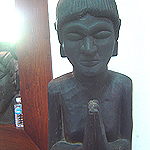
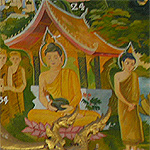
The religious art of Laos is primarily Buddhist and central to it is the Buddha image, depiction of events from the Jataka tales - folk tales written down after the Buddha's death describing the animal and human forms he had taken in his past 550 lifetimes on his journey to enlightenment, mythological stories and religious symbols. These images, paintings and carvings were created, not to please, but as objects of respect and devotion and their purpose was to instruct, enlighten and deepen faith, bringing merit to both the creator and the person commissioning the object. Somkiart Lopetcharat in his book, "Lao Buddha - The image and its history", traces the history of Buddhism and the art of the Lao Buddha in the region and the influences that shaped it, at each stage of its development. Like most Asian countries, Buddhist art in Laos, represented collective knowledge and wisdom that developed and evolved over time. Art forms were copied, duplicated, followed and eventually refined and assimilated into the Lao art traditions, creating a truly Lao style.
BUDDHISM IN LAOS IN BRIEF
To understand the development of Buddhist art, one needs to trace the advent and spread of Buddhism in the country, as well as follow the broad social and political alliances and influences of that time. All these factors contributed to religious art, its origin and its development.
The first Lao Kingdom, Lan Xang was founded in the 14th century by King Fah Ngum after he conquered and unified the lands north of and including Luang Prabang, Xieng Khouang and the Khotrat plateau. Luang Prabang, named after Pra Bang, the Buddha image, remained the capital of Lan Xang for approximately 200 years, until it was moved to Vientiane in the mid 16th century.
In the year 1358, King Fah Ngum's wife Queen Kaew Kengya, of Cambodian origin and a devout Buddhist, asked him to establish Buddhism in Lan Xang. The people of Lan Xang at that time followed various animist practices. Fah Ngum sent tribute to the Khmer king, in Cambodia, and requested for a Buddhist mission to Lan Xang. The Khmer King sent a mission of monks, headed by Phra Mahapasaman. The Khmer king also sent The Pra Bang, and sculptors, goldsmiths, silver-smiths, blacksmiths, and musicians to accompany the monks.
(The Pra Bang, regarded as the protector of the Lao kingdom, is an image of the Buddha, created in the Mon-Khmer style and cast in a mixture of brass, gold, silver, zinc and copper. It is believed to possess strong protective powers. The image is 83 centimeters tall, weighs 52 kilograms, and portrays the Buddha standing with arms raised forward at the elbows, palms facing forward. This hand gesture signifies Bestowing Favours, assurance and protection. Tradition maintains that the relics of the Buddha are contained in the image.
Phra Mahapasaman led the procession with the Pra Bang along the Mekong River to Vientiane. A three-day celebration of prayer was held to mark their arrival. The Buddha image was then transported to Vieng Kham, amidst similar celebrations. The sacred Buddha image was then to be transported to Chieng Thong (Luang Prabang), but could not be carried. This was interpreted to mean that The Pra Bang wished to remain in Vieng Kham.
During his time, King Fah Ngum and his queen promoted Buddhism. They built a temple for the monks, in the north, which later came to be known as the Wat Pasaman and numerous other temples. A reliquary was added to this in 1364 to house the relics of the Buddha's right thumb. Later Wat Phra Kaew was built for The Emerald Buddha, which the queen had brought with her from Cambodia.
But, the Golden Age of Buddhism came some two centuries later. The 16th century witnessed an extraordinary flowering of Buddhist art and architecture in Lan Xang, with three illustrious kings - Wisunarath (1501-1520), Photisarath (1520-1550) and Sai Setthathirat I (1550-1571). By the 17th century, the kingdom of Lan Xang entered a period of decline marked by dynastic struggle and conflicts with its neighbors.
It was during the reign of King Suriyawongsa Thammikaraj (1638-95), once again, a number of temples were built, and Buddha images were cast. His rule brought peace to the land and Vientiane emerged as an important centre for Buddhist learning. According to Lao belief, the king sat upon the throne because of his good karma and he was expected to continue that good work during his lifetime by following the principles of kingship, supporting the Buddhist order and promoting Buddhism through royal patronage and other means.
After his reign, however, the kingdom broke up into three separate states: Luang Prabang in the north, Vientiane in the center, and Champassak in the south. Eventually all three came under Thai rule. This period is characterised by a decline in Lao Buddhist art. While temples continued to be maintained, new ones were not built nor were fresh Buddha images cast.
Following their colonization of Vietnam, the French integrated all of Laos into the French empire. The Franco-Siamese treaty of 1907 defined the present Lao boundary with Thailand.

THE LAO BUDDHA
Somkiart Lopetcharat in Lao Buddha - The image and its history writes, "The original Buddha images which came from Cambodia continued to exert an influence over Lao Buddhist art until the Lan Xang sculptors were able to create their own original and identifiable style. At this point, the art of the Lan Xang Buddha image became distinctly Lao. The art of the Lao Buddha image is conservative and traditional, adopting only influences that blended rather than clashed with it. Thus, the present-day Lao Buddha images differ little from those created in the past."
The early Buddha images were heavily influenced by the Pra Bang. A distinctive Lao style began to emerge only between 1456 and 1520. It blended the Khmer post-Bayon, Lanna, and Sukhothai styles with elements from the early Ayutthaya period.
During this period, the casting of Lao Buddha images was done in components. For example, the radiance was cast separately from the head and later joined to it; the pedestal was cast separately and sometimes served as a reliquary. The various components were assembled by means of tonged and grooved joint techniques indicating skilled craftsmanship.
The alloy was copper and tin mixed with lead, silver, and gold. The Buddha images of this period are very beautiful.
During the Golden Age of Buddhism, 1520-1770, the images show an originality of style. Somkiart Lopetcharat writes, "The eyes, which were formerly downcast, now look straight ahead and are wide open. They are lined with silver or mother-of-pearl. Inlaid black sapphires serve as the pupils. The lips are covered with silver or in a gold and copper alloy. A wide variety of styles, quite high and beautiful, might be derived from the Ayutthaya-Prasatthong style. The selection of metals and the casting indicate exquisite craftsman-ship. Images cast by royal command have a greater percentage of gold. An alloy with a percentage of silver and gold was one of the identifying features and very popular solutions of alloy mixtures were used in the casting of Lao Buddha images during this period."
It is important to understand that while the depiction of the Buddha image itself evolved and changed - both in terms of appearance and expression and the techniques and materials used; what did not change are the postures and hand gestures and their interpretation.

TRADITIONAL RULES FOR MAKING BUDDHA IMAGES
A Buddha is said to have 32 features that represent his exalted state and distinguish him from ordinary human beings; 31 characteristics can be depicted in a statue or an image, only one characteristic "clear and far reaching voice" has to be imparted to a believer. However, these traditions vary from country to country and there are no universal norms regarding the Buddha's appearance. Most Buddha images have some of the following characteristics:
- Hair curled in tight snail-like whorls representing his short hair which he cut as a sign of renunciation and humility
- Elongated ears (from wearing jewelry as a young prince)
- All the fingers and toes are of the same extended length
- Beak like long aquiline nose
- Broad shoulders
- The bulge or protrusion at the top of his head signifying great mental powers and the Buddha's transcendent knowledge
- A whorl of hair between the eyebrows that is also often depicted as a dot, a sign of his transcendent nature
- Simple garments of a monk: a robe, and sometimes a shawl, no adornments
- A serene expression and half-closed eyes signify meditation and inner peace
- Eyes half-open to show awareness and compassion for the devotee
- Often his lips reveal the hint of a smile, another sign of compassion

MEANING OF BUDDHA IMAGES
Every Buddha figure communicates meaning. One of the most important characteristics of a Buddha image are the mudras or hand gestures - each symbolizes some aspect of the Buddha's life or denotes a special characteristic. These well-defined gestures have a fixed meaning throughout all styles and periods of the Buddha image. There are several symbolic hand mudras and nearly all Southeast Asian Buddha images are made in one of them:
Dispelling Fear or imparting fearlessness: This represents the Buddha promising his followers tranquility, protection and courage if they accept and follow the Law.
Generally the right hand is raised to shoulder height with the palm facing outwards and fingers pointing upwards in a universal gesture of protection, benevolence, and peace and the dispelling of fear. The wrist is bent at a right angle to the forearm. The gesture is sometimes made with both hands. In Laos, this mudra is associated with a walking Buddha.
Teaching: Here, the right hand is raised with palm facing outwards and the index finger and thumb forming a circle. The other three fingers point upward. The circle formed by the thumb and index finger is the sign of the Wheel of Law or perfection. This gesture is often portrayed with both hands.
Teaching the First Sermon: Both hands are together at the chest with fingers on one hand forming a circle representing the "wheel of law" while the other hand touches the wheel to set it in motion or "to turn the wheel of Dharma". The hands are generally held close to the chest, at level with the heart. It symbolises one of the most important moments in the life of the Buddha, the occasion when he preached to his former companions the first sermon after His Enlightenment, in the Deer Park at Sarnath, representing the beginning of Buddhist teaching.
Meditation: Both hands resting together on the lap with palms facing upwards. The right hand is on top of the left hand. The Buddha is most often seated in the half-lotus posture or full-lotus posture with tightly crossed legs, so that the soles of both feet are visible. The gesture symbolizes perfect balance of thought and tranquility. In South East Asia, this mudra is frequently used in the image of the seated Buddha.
Calling the Earth to Witness: shows the Buddha seated with crossed legs, palms facing inwards, the fingertips of the right hand touching the ground as he "calls the earth to witness" his enlightenment. The gesture symbolizes unshakable faith and resolution and is the most common posture for Southeast Asian temple images.
Passage to Nirvana: The reclining Buddha represents the Buddha's passing away and symbolizes complete peace and detachment from the world.
Offering or Wish Granting: depicts the standing Buddha with arms outstretched in front of his body, palms opened out and the tips of the fingers pointing downwards to the earth. This mudra represents the Buddha blessing his followers and offering of the Buddhist teaching to the world. Sometimes the teaching, and its benefit, is symbolically represented by a small piece of medicinal myroloban fruit.
This mudra symbolises offering, giving, welcome, charity, compassion and sincere boon granting. It is nearly always made with the left hand.
Two types of standing Buddha images are distinctive to Laos. These are:
Calling for Rain: Depicts a majestic Buddha standing with hands held rigidly at his side, fingers pointing towards the ground. At the bottom, the figure's robes flare out upwards on both sides in a perfectly symmetrical fashion that is also unique and innovative.
Contemplating the Bodhi Tree: In this image the Buddha is standing in much the same way as in the 'Calling for Rain' pose, except that his hands are crossed at the wrists in front of his body. (The Bodhi tree, or 'Tree of Enlightenment', refers to the large banyan tree that the historical Buddha purportedly was sitting beneath when he attained enlightenment in Bodhgaya, India, in the 6th century BC.)
Midget Lao Buddha Images: Since ancient time, people of many religions have cast midget or miniature idols including Buddhas. In ancient times these tiny Buddhas were always wrapped up in a piece of doth and tied about the head above the ears while people were at work or in battle. The very tiny Lan Xang (Lao) Buddha images in alloys of various metals are classified as amulets.
FEATURES OF THE LAO BUDDHA
Standing Buddha images exhibit Khmer and Thai influences, while seated images are uniquely Lao, and show characteristics such as a beak-like nose, extended earlobes, tightly curled hair, and long hands and fingers.
The Radiance
The shape of the radiance depended on the origins of the creator of the image and took many shapes:
- cover of an earthenware pot
- a glass ball
- lotus bud
- high pointed-cone shape on a square base decorated with lotus buds beneath
- flame shape, during 'The Golden Age'
- clusters of lotus petals. Luang Prabang Buddhas feature lotus clusters engraved delicately.

MATERIALS
Lao Buddha sculptures use a variety of mediums, including bronze, wood, gold and silver and precious stones.
Of these, bronze is by far the most common and has been used to create many important Buddha statues, including:
- the images at Wat Manorom in Luang Prabang (14th century) - only the head and torso remain and reveal that the colossal bronzes were cast in parts and assembled in place
- The images at Wat Ong Tu and Wat Chanthaburi (Wat Chan) in Vientiane (16th century).
- Teak - a durable, hard wood with a rich brown color.
- Yemane - a moderately hard wood with a whitish colour that sometimes has strains of green or gray.
- Padauk - a beautiful reddish colour
- Ebony - a dark coffee brown colour
- Sandalwood - a caramel colour wood with a rich aroma
- Rainwood - because of the uneven colour this wood is used not for carving but for being painted on
BUDDHIST PAINTING and CARVING
Many scenes are carved or painted as murals on temple walls, such as the Buddhist sculptures in the Pak Ou caves. Buddhist painting features Buddha images, representations from the Jataka tales and the Lao version of the Ramayana known as the "pharak pharam" and also other symbols and representations. There are strict rules that govern the depiction of the Buddha and other important figures. The size, position or placement of a figure, with respect to the central figure or deity, indicates its importance or hierarchy in a story or representation.
These paintings are made using simple lines and plain colour, with no shadow or shading. Their purpose was to serve as a means of enhancing religious worship. They took two main forms:
- bas-relief murals
- painted preaching hanging cloths
Budithi Bell and Brass Craft of Andhra Pradesh,
Bindelu vessels are made from brass metal, which is an alloy of copper and zinc. It is only made in Budithi, in Andhra Pradesh’s Srikakulam district. It is a two-piece vessel which is formed by beating two different sheets of brass till the required shape is achieved. The two pieces are welded together and then finished from the inside. The mouth of the vessel is made by welding a cast ring on to the finished sphere. Finally, the outer surface of the vessel is scraped and polished, which adds a lustre to the piece. Bells cast from bell metal are used in temples, and are one of the oldest and most famous crafts of Budithi. The product is normally in high demand throughout the year. The bells are highly resonant and provide a longer lasting sound than most other bells.
Bindelu vessels are made from brass metal, which is an alloy of copper and zinc. It is only made in Budithi, in Andhra Pradesh’s Srikakulam district. It is a two-piece vessel which is formed by beating two different sheets of brass till the required shape is achieved. The two pieces are welded together and then finished from the inside. The mouth of the vessel is made by welding a cast ring on to the finished sphere. Finally, the outer surface of the vessel is scraped and polished, which adds a lustre to the piece. Bells cast from bell metal are used in temples, and are one of the oldest and most famous crafts of Budithi. The product is normally in high demand throughout the year. The bells are highly resonant and provide a longer lasting sound than most other bells.
Bullock Cart Making of Rajkot, Gujarat,

 Originally used for agricultural purposes and transportation, bullock carts are also function as vehicles during marriages. The entire craft is fashioned by a single craftsperson executing both metal and wood work. Detailed ornamentation and carving is carried out laboriously by the craftsperson to embellish the cart. Tools such as saws, hammers, chisels and planers are employed for the crafting process.
Originally used for agricultural purposes and transportation, bullock carts are also function as vehicles during marriages. The entire craft is fashioned by a single craftsperson executing both metal and wood work. Detailed ornamentation and carving is carried out laboriously by the craftsperson to embellish the cart. Tools such as saws, hammers, chisels and planers are employed for the crafting process.

 Originally used for agricultural purposes and transportation, bullock carts are also function as vehicles during marriages. The entire craft is fashioned by a single craftsperson executing both metal and wood work. Detailed ornamentation and carving is carried out laboriously by the craftsperson to embellish the cart. Tools such as saws, hammers, chisels and planers are employed for the crafting process.
Originally used for agricultural purposes and transportation, bullock carts are also function as vehicles during marriages. The entire craft is fashioned by a single craftsperson executing both metal and wood work. Detailed ornamentation and carving is carried out laboriously by the craftsperson to embellish the cart. Tools such as saws, hammers, chisels and planers are employed for the crafting process.
Bundi Paintings of Kota, Rajasthan,
Bundi was one of the important schools of Rajasthani school of paintings, which originated in the 17th century. In its earlier stages, Bundi paintings could not be distinguished from Kota school of paintings because they were united until the second quarter of the seventeenth century. The earliest of the Bundi paintings are Ragamala, which can be seen in Chunar. Bundi paintings showed picturesque landscape, dramatic skies, thick jungles, flowing rivers, lotus ponds, etc. The themes were generally court scenes, festivals, processions, the life of people, Harem or Zenana scenes, hunting scenes, portraits etc. During its mature phase of Bundi paintings, human figures were seen with a reddish brown complexion. Females wearing odhani (veil), choli (blouse) and ghaghra (skirt) are seen, whereas men are seen wearing jamas (long coats) over churidar pyjamas. They are also seen wearing turbans adorned with feather occasionally. The architecture and interiors in the paintings are illustrated elaborately. Domed pavilions, interior with alcoves, chajjas (overhanging eaves), etc. are usually set in the landscape setting of the painting. Towards the end of the 17th century, paintings underwent few changes. It showed human complexion in flesh – pink color and faces more refined. Water is seen with wavy white lines against a dark indigo background. Artists also started using vivid colors for the sky and the landscape. They also started painting elephants, a huge animal with such ease and fluidity. A painting in Prince Wales Museum (now known as Chhatrapati Shivaji Maharaj Vastu Sangrahalaya), known as Summer Elephant shows hot colors – red, orange and yellow with great ease. Artists favourite themes during this period were Krishna and its legends, along with Baramasa and Rangmala. Towards the end of the eighteenth century, there was a gradual decline in the Bundi school of paintings.
Bundi was one of the important schools of Rajasthani school of paintings, which originated in the 17th century. In its earlier stages, Bundi paintings could not be distinguished from Kota school of paintings because they were united until the second quarter of the seventeenth century. The earliest of the Bundi paintings are Ragamala, which can be seen in Chunar. Bundi paintings showed picturesque landscape, dramatic skies, thick jungles, flowing rivers, lotus ponds, etc. The themes were generally court scenes, festivals, processions, the life of people, Harem or Zenana scenes, hunting scenes, portraits etc. During its mature phase of Bundi paintings, human figures were seen with a reddish brown complexion. Females wearing odhani (veil), choli (blouse) and ghaghra (skirt) are seen, whereas men are seen wearing jamas (long coats) over churidar pyjamas. They are also seen wearing turbans adorned with feather occasionally. The architecture and interiors in the paintings are illustrated elaborately. Domed pavilions, interior with alcoves, chajjas (overhanging eaves), etc. are usually set in the landscape setting of the painting. Towards the end of the 17th century, paintings underwent few changes. It showed human complexion in flesh – pink color and faces more refined. Water is seen with wavy white lines against a dark indigo background. Artists also started using vivid colors for the sky and the landscape. They also started painting elephants, a huge animal with such ease and fluidity. A painting in Prince Wales Museum (now known as Chhatrapati Shivaji Maharaj Vastu Sangrahalaya), known as Summer Elephant shows hot colors – red, orange and yellow with great ease. Artists favourite themes during this period were Krishna and its legends, along with Baramasa and Rangmala. Towards the end of the eighteenth century, there was a gradual decline in the Bundi school of paintings.
Burnt Bamboo and Woodcraft of Bastar, Chattisgarh,
Wooden pillars called Urusguttas are erected in the memory of prominent tribe members in the hilly tracts of Bastar. The main tribal groups found in this region are the Marias and Muria Gonds. Wood is found in abundance in this region and the tribals excel in wood-carving. Urusguttas are wooden tetrahedral structures made from the bark of Termialia tomentosa, and vary in height from four to eight feet. They are topped by a roughly hewn block of wood in the shape of the number eight, with the apex or tip tapered and marked with a series of deeply incised lines. At the junction of the block and the square roof of the main pillar are figures of carved birds attached to iron rods projecting in four directions. The pillars are carved on all four sides with each face divided into four or six rectangles or square panels. The carvings include human beings, animals, birds, trees, and other familiar figures in the tribal world. An evolved style of wood-carving is also found in the ghotuls or youth dormitories where young boys and girls were supposed to acquaint themselves with one another before marriage. The wooden doors, beams and posts are all carved with motifs of human beings, floral ornaments, geometrical patterns, and animals such as deer, bison and fish; other common motifs are combs, tortoises, birds, and dancing figures weaving bison-horn headgear. Combs, used mainly as hair ornaments, are another example of the skill of wood-carving or etching. The designs found on them are intricate --- delicately incised embellishments of rectilinear and geometrical forms such as triangles; flowing lines; diagonal and criss-cross hatching; and herring-bone bonds. Wooden tobacco containers are also exquisitely carved. They are often shaped in the form of wheels, fishes or mangoes. The ornamentation is mainly geometric. The other items that are carved include dancing sticks, drums, low seats, and dried gourd called bhurka used as vessels.
Wooden pillars called Urusguttas are erected in the memory of prominent tribe members in the hilly tracts of Bastar. The main tribal groups found in this region are the Marias and Muria Gonds. Wood is found in abundance in this region and the tribals excel in wood-carving. Urusguttas are wooden tetrahedral structures made from the bark of Termialia tomentosa, and vary in height from four to eight feet. They are topped by a roughly hewn block of wood in the shape of the number eight, with the apex or tip tapered and marked with a series of deeply incised lines. At the junction of the block and the square roof of the main pillar are figures of carved birds attached to iron rods projecting in four directions. The pillars are carved on all four sides with each face divided into four or six rectangles or square panels. The carvings include human beings, animals, birds, trees, and other familiar figures in the tribal world. An evolved style of wood-carving is also found in the ghotuls or youth dormitories where young boys and girls were supposed to acquaint themselves with one another before marriage. The wooden doors, beams and posts are all carved with motifs of human beings, floral ornaments, geometrical patterns, and animals such as deer, bison and fish; other common motifs are combs, tortoises, birds, and dancing figures weaving bison-horn headgear. Combs, used mainly as hair ornaments, are another example of the skill of wood-carving or etching. The designs found on them are intricate --- delicately incised embellishments of rectilinear and geometrical forms such as triangles; flowing lines; diagonal and criss-cross hatching; and herring-bone bonds. Wooden tobacco containers are also exquisitely carved. They are often shaped in the form of wheels, fishes or mangoes. The ornamentation is mainly geometric. The other items that are carved include dancing sticks, drums, low seats, and dried gourd called bhurka used as vessels.
Calligraphy of Lucknow, Uttar Pradesh,
Quitabat or Calligraphy is practiced in Lucknow by skilled calligraphers since centuries. The art was first brought to India by Turkish Sultans in 1200 AD. Many examples of unparalleled calligraphy can be found from this period where several Persian and Arabic texts were reproduced and illustrated in Iranian styles, incorporating Indian elements. Tughra, a complex and stylized calligraphic style was used by Turkish sultans as their monographs. Tools such as brushes, reed pens/bet muishk, agate for burnishing and fixing colours, jade for mixing gold foil and paint and opal for burning are used by the calligraphers.
Quitabat or Calligraphy is practiced in Lucknow by skilled calligraphers since centuries. The art was first brought to India by Turkish Sultans in 1200 AD. Many examples of unparalleled calligraphy can be found from this period where several Persian and Arabic texts were reproduced and illustrated in Iranian styles, incorporating Indian elements. Tughra, a complex and stylized calligraphic style was used by Turkish sultans as their monographs. Tools such as brushes, reed pens/bet muishk, agate for burnishing and fixing colours, jade for mixing gold foil and paint and opal for burning are used by the calligraphers.
Calligraphy on Stone,
Carved stones with Buddhist calligraphy are found in many places in Nepal. These stones have traditionally been placed along paths that lead to monasteries. In recent years religious iconography and calligraphy carved into stones is also being done for the tourist market.
Carved stones with Buddhist calligraphy are found in many places in Nepal. These stones have traditionally been placed along paths that lead to monasteries. In recent years religious iconography and calligraphy carved into stones is also being done for the tourist market.
Calligraphy on Stone in Delhi,
In old Delhi a family still continue engraving stones for the graves in calligraphy. The art of engraving gravestones or Kunda karma is a painstaking task and requires immense patience and endurance. The cost of gravestone ranges from Rs. 300/- to Rs 1000/- depending on the kind of stone and number of words engraved.
In old Delhi a family still continue engraving stones for the graves in calligraphy. The art of engraving gravestones or Kunda karma is a painstaking task and requires immense patience and endurance. The cost of gravestone ranges from Rs. 300/- to Rs 1000/- depending on the kind of stone and number of words engraved.
Camel Bone Carving of Uttar Pradesh,
Lucknow has been a prominent center for ivory carving. From creating court objects for the Nawabs of Awadh to carrying out the craft on furniture as initiated by the British, ivory carving has been a significant part of the craft repertoire. Due to the worldwide ban on ivory, the the craftsmen has since been carving on camel and buffalo bone. Products like openwork boxes, lamps, scissors, paper knives, pen stands, buttons, earrings, necklaces, rings, pendants and ambari elephant are crafted by the artisans.
Lucknow has been a prominent center for ivory carving. From creating court objects for the Nawabs of Awadh to carrying out the craft on furniture as initiated by the British, ivory carving has been a significant part of the craft repertoire. Due to the worldwide ban on ivory, the the craftsmen has since been carving on camel and buffalo bone. Products like openwork boxes, lamps, scissors, paper knives, pen stands, buttons, earrings, necklaces, rings, pendants and ambari elephant are crafted by the artisans.
Camel Girth / Split Ply Braiding and Animal Trapping of Rajasthan,
These are called the split ply camel girths of Rajasthan. They are worked by hand and the loom is not used; they are simple, decorative and useful. The sturdy girths of the camels are prepared using a unique technique mainly using goat hair; cotton cord is also used sometimes. The black or white hair of the goat is woven into yarn on the spindle. The yarn is doubled to make it two-ply; four-ply yarn is used for girth, with each ply being two-ply. To make the four-ply yarn a mixture of black and white, two white two-plys are plied with two black two-plys. The four-ply is highly twisted as it needs to be manipulated, twisted and untwisted in the processing. After twisting, the four-ply yarn is soaked in water and stretched out in the sun to dry. This removes the kinks, opens up and thickens out the yarn and sets the over twist. When the yarn is dry, the four-ply cords are looped and slipped on to a wooden stick or spindle. The adjacent plys are taken, and the ply of one cord is split open with the eye end of a large wooden needle and untwisted to a quarter of a turn; the next cord is threaded through the eye and is pulled back through the first strand. The adjacent cords have this process done along the row, and worked down, row by row, where each individual cord reaches down and across the newly created fabric on a diagonal line ending on the selvedge. The direction of the cord turns down and across in the opposite side and ultimately zigzags down the fabric from selvedge to selvedge. The pattern is decided by the girth-maker who decides whether the cord is split or to be split by the cord it meets along the opposite diagonal. There are standard variations in pattern. These are monochrome (some colour, mainly black), a black and white diagonally chequered pattern, or alternating black and white horizontal waves. The best pattern is when the four ply yarn is half black and half white. The cord here is untwisted in the cord splitting process so that two plys of the same colour remain on the surface. The diagonally interlaced layer of one colour lies on the top of the diagonally interlaced layer of the other colour in the refined technique. When the cord is twisted, colours are counter-changed and the free-floating layers are linked together. Items such as camel girth, necklace, anklet, knee band, bridle etc are created under this craft-form. Tools such as wooden hook are used for crafting purposes.
These are called the split ply camel girths of Rajasthan. They are worked by hand and the loom is not used; they are simple, decorative and useful. The sturdy girths of the camels are prepared using a unique technique mainly using goat hair; cotton cord is also used sometimes. The black or white hair of the goat is woven into yarn on the spindle. The yarn is doubled to make it two-ply; four-ply yarn is used for girth, with each ply being two-ply. To make the four-ply yarn a mixture of black and white, two white two-plys are plied with two black two-plys. The four-ply is highly twisted as it needs to be manipulated, twisted and untwisted in the processing. After twisting, the four-ply yarn is soaked in water and stretched out in the sun to dry. This removes the kinks, opens up and thickens out the yarn and sets the over twist. When the yarn is dry, the four-ply cords are looped and slipped on to a wooden stick or spindle. The adjacent plys are taken, and the ply of one cord is split open with the eye end of a large wooden needle and untwisted to a quarter of a turn; the next cord is threaded through the eye and is pulled back through the first strand. The adjacent cords have this process done along the row, and worked down, row by row, where each individual cord reaches down and across the newly created fabric on a diagonal line ending on the selvedge. The direction of the cord turns down and across in the opposite side and ultimately zigzags down the fabric from selvedge to selvedge. The pattern is decided by the girth-maker who decides whether the cord is split or to be split by the cord it meets along the opposite diagonal. There are standard variations in pattern. These are monochrome (some colour, mainly black), a black and white diagonally chequered pattern, or alternating black and white horizontal waves. The best pattern is when the four ply yarn is half black and half white. The cord here is untwisted in the cord splitting process so that two plys of the same colour remain on the surface. The diagonally interlaced layer of one colour lies on the top of the diagonally interlaced layer of the other colour in the refined technique. When the cord is twisted, colours are counter-changed and the free-floating layers are linked together. Items such as camel girth, necklace, anklet, knee band, bridle etc are created under this craft-form. Tools such as wooden hook are used for crafting purposes.
Camel Leather Craft of Rajasthan,
Bikaner, one of the three main destinations in the tourist desert circuit of Rajasthan is known as camel country as the camels here are said to be best in the world for riding purposes. Bikaner also boasts of the largest Camel research and breeding farm in the World which was initiated by the central government. The National research center for Camel not only researches the camel, and in all its aspects - hair and milk etc. Bikaner has also been known for the use put to camel skin including the crafting of handmade objects. The community of dapgars process the skin of camel to make traditional Rajasthani drums and camel skin decorative items from bottles, vases, bowls etc. There is only one traditional dapgar family in Bikaner still processing the camel skin for usage. They make objects like flasks, bottles and vases from camel skin. The objects made by them are used bythe well known Usta community to paint them in Gesso or Usta kaam.
Bikaner, one of the three main destinations in the tourist desert circuit of Rajasthan is known as camel country as the camels here are said to be best in the world for riding purposes. Bikaner also boasts of the largest Camel research and breeding farm in the World which was initiated by the central government. The National research center for Camel not only researches the camel, and in all its aspects - hair and milk etc. Bikaner has also been known for the use put to camel skin including the crafting of handmade objects. The community of dapgars process the skin of camel to make traditional Rajasthani drums and camel skin decorative items from bottles, vases, bowls etc. There is only one traditional dapgar family in Bikaner still processing the camel skin for usage. They make objects like flasks, bottles and vases from camel skin. The objects made by them are used bythe well known Usta community to paint them in Gesso or Usta kaam.
Camel Skin Craft,
The camel skin is cleaned with the help of a scraper or "rambi". The hair is also removed with another "rambi". The damp skin is cut into smaller pieces and pounded flat with a rounded grinder. Thus cleaned and treated, the small pieces of skin are stretched and pasted mounted on to a mould of desired shape with the use of the hands. Any gap between the pieces is checked and refilled with "gooda" (paste). Checked again. This is dried in the sun. When dry, the mould inside is broken and the skin which has acquired the shape of the mould, cleaned and dried. The object is then ornamented with multicoloured lacquer painting of designs of floral and geometric patterns bearing distinct Mughal and Persian influence. Three major craftsmen are namely the Kumhar (potter), the dabgar (the camel skin worker) and Naqqash (the painter).
The camel skin is cleaned with the help of a scraper or "rambi". The hair is also removed with another "rambi". The damp skin is cut into smaller pieces and pounded flat with a rounded grinder. Thus cleaned and treated, the small pieces of skin are stretched and pasted mounted on to a mould of desired shape with the use of the hands. Any gap between the pieces is checked and refilled with "gooda" (paste). Checked again. This is dried in the sun. When dry, the mould inside is broken and the skin which has acquired the shape of the mould, cleaned and dried. The object is then ornamented with multicoloured lacquer painting of designs of floral and geometric patterns bearing distinct Mughal and Persian influence. Three major craftsmen are namely the Kumhar (potter), the dabgar (the camel skin worker) and Naqqash (the painter).
Candle Making in Punjab,
Menawati or candle making is a traditional craft. Made by pouring molten wax (earlier beeswax collected in the jungles) into moulds in which there is a cotton wick, the other process followed is by pouring molten wax down a wick. White candles and arrange of other color candles are made using chemical color additives.
Menawati or candle making is a traditional craft. Made by pouring molten wax (earlier beeswax collected in the jungles) into moulds in which there is a cotton wick, the other process followed is by pouring molten wax down a wick. White candles and arrange of other color candles are made using chemical color additives.
Candle Making of Assam,
Candle making is practiced all across India. However, there are always regional variations.
Candle making is practiced all across India. However, there are always regional variations.
Candle Making of Karnataka,
Candle making is practiced all across India. However, there are always regional variations present.
Candle making is practiced all across India. However, there are always regional variations present.
Candle Making of Manipur,
Candle making is practiced all across India. However, there are always regional variations present.
Candle making is practiced all across India. However, there are always regional variations present.
Candle Making of Pondicherry,
Candle making is practiced all across India. However, there are always regional variations present.
Candle making is practiced all across India. However, there are always regional variations present.
